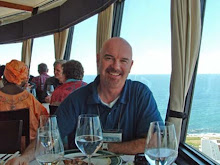



The mid-point of the conference was a break-away from the sessions and learning groups. The first half of the day was a visit to Gugulethu Township. When Apartheid was enacted, Blacks and Coloureds (the official S.A. term for anyone of Asian or ‘mixed’ racial background) were forcibly removed to settlements isolated from the Whites. Gugulethu is about half-an-hour from Cape Town, and is a dense neighbourhood of houses, shops, churches, businesses, etc. In contrast to the so-called ‘informal settlement’s which are the corrugated metal shanty-towns, Gugulethu seems almost middle-class, but it is certainly not wealthy or even comfortable.
We were hosted by the Gugulethu Presbyterian Church. Note in the picture that all the windows are barred, and the church is surrounded by a high metal fence with razor wire on top. This is typical of most houses and buildings in many parts of Cape Town. Even low walls that can be easily climbed over will have strips of sharp metal spikes protruding from the top to discourage people from hopping over, or even sitting on the wall. It’s really unclear whether there is a serious safety threat this is meant to address, or is more symbolic of security and a siege mentality. I’ve wandered around a bit in our neighbourhood, and not felt at risk at all, but all the nearby houses are protected like this.
Pastor Mzukisi at the church in Gugulethu did speak of the social conditions, noting that the poverty is now wreaking more damage on the social fabric than the remnants of Apartheid. Adding to the problem is the HIV AIDS pandemic, in which one in four deaths in Africa is now attributable to AIDS. With so few resources, medication and medical care are beyond reach when there isn’t enough money for basics such as food, shelter, and clothing. A member of the church spoke about her diagnosis with HIV, her struggles with the stigma, and trying to get the money for medication. We also heard from an older woman who grew up during the Apartheid era and was resettled numerous times, eventually settling in Guglethu.
The whole Apartheid ethic was based on eugenics, much like Grant and I saw on exhibit in Ottawa at the War Museum. Here they used a number of simple measurements to determine where a person fell in the race spectrum from white to black. It wasn’t about blood lines as much as about appearance. We heard of a story where two brothers, children of a mixed marriage (married before Apartheid outlawed such relationships), were determined to be of different races and segregated because one had characteristics of the white mother, and the other characteristics of the black father. The system ruled where you could live, work, and travel, your education and work, and relationships. And somehow it was rationalized to be, well, rational.
Like churches everywhere, Gugulethu Presbyterian runs on the sweat of the women. About the same time we arrived (about 300 of us) a dozen women also arrived bearing the makings of the meal. While we listened to the ministers and the to stories of Koleka and Nonkosi, the other women were cooking up a storm. We had a great meal of rice and bean, carrots and greens, and some kind of curry. The women sang African hymns and danced in a tight circle while we were eating. Everyone does seem very warm and friendly, interested in hearing about Canada and places far away, and despite the hardships seem to have a joy in life.

2 comments:
"The whole Apartheid ethic was based on eugenics, much like Grant"
Huh?
Sorry, Grant, there was a part of the sentence missing. It was meant to refer to the exhibit we saw at the Canadian War Museum on Ottawa on Eugenics.
Post a Comment